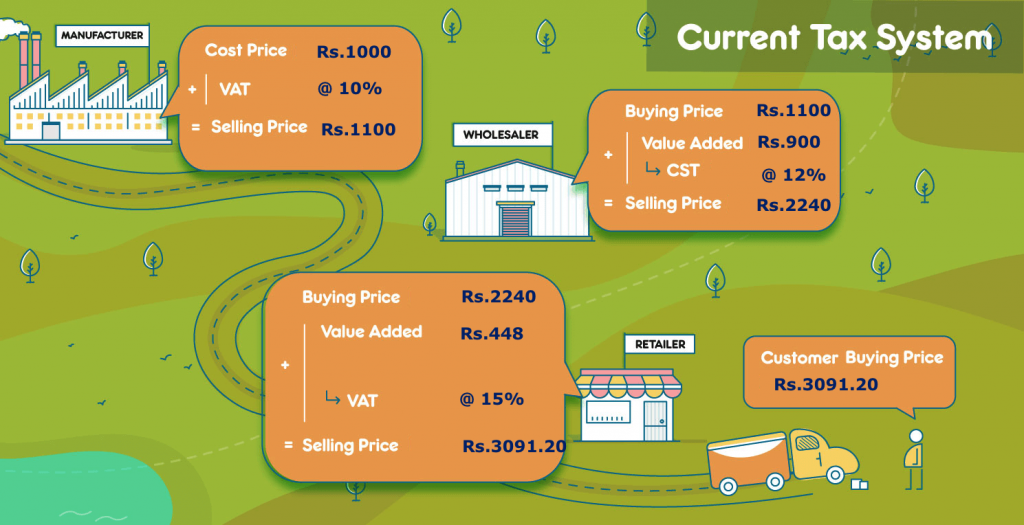
GST is a single tax that has subsumed several indirect taxes that were previously levied on the sale of goods and services. It is applicable to the manufacture, sale, and consumption of all goods and services in India.

This section will cover the following topics
The previous tax system involved multiple taxes, complex compliance procedures, and intervention by several State and Central tax divisions. This made it highly difficult to set up and run a business in India.
Under the GST regime, instead of applying taxes on the total value of the product at each stage, the GST only imposes tax on value addition. Since it provides credit for the input tax paid at each previous stage of a supply chain, this method considerably reduces the overall cost of manufacturing and selling goods.
Instead of applying taxes on the total value of the product at each stage, the GST only imposes tax on value addition. Because it provides credit for the input tax paid at each previous stage of a supply chain, this method considerably reduces the overall manufacturing cost.
Let’s take a closer look at how this works with a simple example.
Comparison of Previous Tax Structure vs. GST
Imagine a manufacturer selling zinc-coated steel buckets to a wholesaler located in the same state (let’s call it State 1) for Rs. 1,000 each plus tax.
Note: In this example, we are assuming that all taxes associated with the manufacturing process have been paid and the selling price in the first stage is the final price set by the manufacturer (excluding VAT).
Note: Here we have assumed the VAT rate in state 1 to be 10% while the VAT rate in state is 15%. This is because under the pre-GST system, the VAT rates are different across different states.
In the above example, you can see that at every stage of the process, the application of tax is non-uniform. The tax rate and type are different each time, and getting ITC is difficult or impossible because the different taxes are governed by different authorities.

Now, let’s take the same example, but instead apply the GST model.
Note: Here, we have assumed the GST on zinc-coated steel buckets to be 10%. GST for the bucket will stay the same throughout India, irrespective of whether it is an intra-state sale or inter-state sale.

Bottomline – Looking at both the examples, one can see that there is not much difference to the buyer/end consumer. The benefit to the end consumer totally depends on the GST rate associated with a particular item or service under the GST. If we had assumed a higher GST rate for the bucket, the end consumer would have actually paid a lot more than earlier. But then, the real benefit from the GST regime is actually reaped by sellers, manufacturers and traders because the GST allows an unrestricted flow of input tax credits and so they get a refund on the input taxes that they have paid at the time of sale. That said, sellers can pass on this benefit to the end consumer if they choose to by reducing their final selling prices (as they do get their tax money back).
Since July 2017, India has been following the dual-GST model, which is made up of the following components:
When the sale of goods and services takes place within the same state, both taxes will be levied.
If the movement of goods occurs between two different states (i.e., an interstate transaction), a combined tax called the IGST or the Integrated GST (SGST + CGST) will be collected by the central government. The IGST will replace the previously levied Central Sales Tax (CST) of 2%.
The tax amount collected as IGST will later be distributed to respective state governments.
To understand the dual-GST model better, let’s take a look at the following scenarios:
Let us assume that you’re a distributor in Chennai and you buy goods from a manufacturer in Tirupur, Tamil Nadu. Since the sale and movement of goods happen within the state, SGST and CGST will be levied on the sale. You, as the distributor, will get tax credit on the input SGST and CGST.
Let us assume that you’re a distributor in Belgaum, Karnataka, and you buy goods from a manufacturer in Tirupur, Tamil Nadu. Here, the sale and movement of goods happen between two different states, IGST will be levied on the sale.
The four-tier tax structure of GST has the following slabs: a zero rate, a lower rate, two standard rates, and a higher rate. Here’s a brief overview of each GST rate.
The zero rate tax is a nil tax that is applied on goods and services. Zero rated items include milk, eggs, curd, unpacked foodgrains and health & educational services.
A lower rate of 5% will be applied on items like sugar, tea, edible oil, coal, spices, and cotton fabric. This, along with the zero rate, will help prevent inflation from having much of an impact on the prices of essential items.
There are two standard rates that have been finalized by the GST Council: 12% and 18%.
Processed food, butter, and mobile phones will be taxed at 12%. Capital goods, industry intermediaries, toiletries, computers and printers will be taxed the second standard rate of 18%.
A higher rate of 28% will be levied on white goods. This includes items such as washing machines, high-end motorcycles, air conditioners, refrigerators, small cars, etc.
The additional cess, which has been a topic of debate since the GST rates were proposed, is now finalized. It was feared that demerit goods such as tobacco products and aerated drinks, which were previously taxed at 65% and 40%, would become cheaper and too easily accessible if the highest rate of GST was set at 28%. To keep this from happening, the new GST structure will collect an additional cess on top of the 28% GST. The cess will only be applied on demerit goods like like coal, paan masala, tobacco, aerated drinks, and motor vehicles.


















